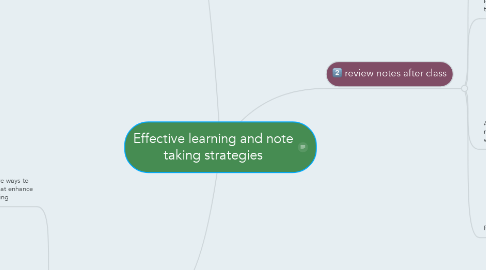
1. review notes after class
1.1. Reviewing notes within 24 hours of learning information has proven to significantly enhance the students recollection of the material learned.
1.2. A good technique that many scholars who study learning strategies emphasize is to annotate in the margin when reviewing lesson notes
1.2.1. Add question marks in unclear areas needing further investigation
1.2.2. Helps to put notes in your own words, or add relevant/helpful information
1.2.3. Digital tools useful for this technique
1.2.3.1. the My Stickies APP
1.2.3.1.1. Lets you add side notes to any webpage with a sticky note
1.3. All learning styles can benefit from reviewing student notes, just in their own way
1.3.1. Visual
1.3.1.1. Rewrite notes
1.3.1.2. Highlight resources
1.3.2. Auditory
1.3.2.1. Watch debates, online videos on subject matter
1.3.2.2. Read out loud, record yourself
1.3.3. Kinesthetic
1.3.3.1. Review while walking or on a treadmill
1.3.3.2. Go back to the classroom you learned it in when reviewing the notes.
1.4. Resources
1.4.1. Cut and Paste 101 New Strategies for Note Taking and Review (Porte)
1.4.1.1. "immediate review of complete notes...appears to improve comprehension and retention of information."
2. summarize lesson
2.1. Three effective ways to summarize that enhance student learning
2.1.1. Write an outline or brainstorming map/web
2.1.1.1. Helps collect and store ideas in an organized format, and is a great tool for students who learn visually. Is also a great first step to take to get ideas from the student's head to paper.
2.1.2. Writing a short paragraph or a few sentences summarizing the main theme of the lesson
2.1.2.1. Helps to initially understand the theme or main objective of a lesson. This technique can be executed more quickly if a student is busy and is efficient.
2.1.3. Put main ideas on notecards
2.1.3.1. This helps separate different ideas and make them stand out in a student's mind
2.2. digital tools
2.2.1. The app One Note
2.2.1.1. Can summarize using handwritten notes, visual images to aid memory, and check lists
2.2.2. The app Workflowy
2.2.2.1. Used to outline notes and ideas
2.3. resources
2.3.1. Classroom Assessment Techniques (Angelo & Cross)
2.3.1.1. "students develop the valuable skill of translating information into words they can understand."
2.3.2. Parallel notetaking: A strategy for effective use of Webnotes (Pardini, Domizi, Forbes, Pettis)
2.4. Forces a student to consider what they learned during a lesson, and write it down in a way that makes sense to them. This helps them think about what they learned, look at the notes to affirm and support their ideas, and write them down.
3. handwrite notes
3.1. Taking notes using a pen/ pencil instead of laptop assists a student in recalling lesson material better
3.2. It forces a student to write main ideas because they can not copy and paste all of the material.
3.3. Is shown in many of studies to have improved a students note taking ability and put more thought into what the student is writing
3.4. Resources
3.4.1. Information Comprehension: Handwritten vs. Typed Notes (Duran & Frederick)
3.4.1.1. "Under the conditions of the current study, handwriting rather than typing notes better facilitates comprehension"
